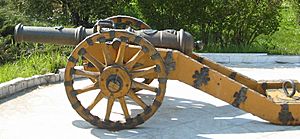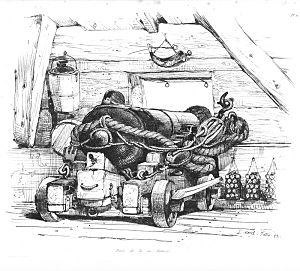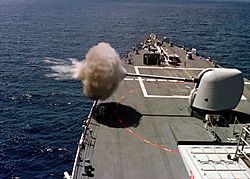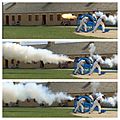Cannon facts for kids
A cannon is a large, tube-shaped weapon that uses gunpowder to shoot a projectile (like a cannonball) a long distance. Cannons come in many different sizes, can shoot different distances, and vary in how easy they are to move and how fast they can fire. Each type of cannon is designed for a special purpose.
Cannons were first used in China. They were some of the earliest weapons to use gunpowder. The first cannons in Europe likely appeared in Spain during wars in the 12th century. English cannons were first used in the Hundred Years' War around 1346 at the Battle of Crécy. Back then, they were small and simple. By the end of the Middle Ages, cannons became more standard and powerful.
Some of the biggest cannons ever built were from Asia, like the Indian Jaivana cannon. European cannons were also large, but people soon preferred lighter, easier-to-move cannons. This led to the modern field artillery we know today. For example, the huge Great Turkish Bombard from the Middle Ages needed 200 people to use it! But by the 18th century, English cannons only needed about 12 people, and during the Napoleonic Wars, a British cannon could be operated by just five people.
Contents
What "Cannon" Means
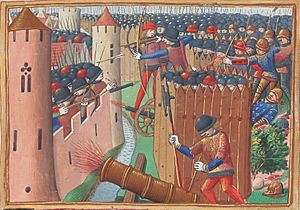
The word cannon comes from the Old Italian word "cannone", which means "large tube." This word came from the Latin "canna", and even further back from the Greek word "kanna." The word "cannon" has been used for guns since 1326 in Italy and 1418 in England.
The word "bombard" was first used for cannons, but after 1430, it only referred to the very largest ones. The word "cannon" can be used for both one cannon or many cannons, though "cannons" is also correct for the plural.
Today, a cannon usually means a large, smooth-barreled gun that was loaded from the front (a muzzle-loader). These were used before guns with spiral grooves inside the barrel and those loaded from the back (called breech-loading). The term also applies to a modern autocannon, which is a gun with a barrel size of 20 mm or more. Autocannons have been used a lot in fighter planes since World War II and sometimes on land vehicles too.
How Cannons Were Used
In the 1700s, operating a cannon was a big job. Each cannon needed a team of two gunners, six soldiers, and four artillery officers.
Before loading, the cannon had to be cleaned with a wet sponge. This was to make sure no burning bits were left from the last shot, which could accidentally set off the new gunpowder. Then, gunpowder was added, followed by a wad of paper or hay, and finally the cannonball. After pushing everything in with a rammer, the cannon was aimed. To get the longest shot, they would aim it at a 45-degree angle. Officers made sure the cannon was used carefully. Water was also kept nearby to cool the cannon down after every 10 or 12 shots.
A large cannon (a 24-pounder) could fire 90 to 100 shots a day in summer. Smaller cannons could fire even more because they were easier to handle. Sometimes, 200 shots were fired in just nine hours!
During the Napoleonic Wars, a British cannon team had five numbered gunners:
- No. 1 was the commander, who aimed the gun.
- No. 2 was the "spongeman." They cleaned the inside of the barrel with a wet sponge to put out any sparks.
- No. 3 was the loader. They put the gunpowder bag and the cannonball into the barrel.
- No. 4 was the "ventsman." They covered the small hole at the back of the cannon to stop air from getting in. Then, they poked the gunpowder bag and filled the vent with powder.
- No. 5 would fire the cannon using a slow-burning fuse when the commander gave the order.
History of Cannons
Early Cannons
An early type of cannon, powered by compressed air, was invented by Ctesibius of Alexandria before 200 BC.
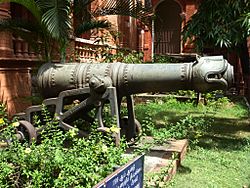
Like other guns, cannons developed from the "fire-lance" in China. This was a tube filled with gunpowder attached to a spear, used like a flamethrower. Sometimes, small pieces of metal were put in the barrel to fly out with the flames. Over time, the paper and bamboo barrels of fire-lances were replaced with metal.
The oldest picture of a gun is a sculpture from China in the 1100s. It shows a person holding a vase-shaped "bombard" with flames and a cannonball coming out. The oldest surviving gun, from 1288, has a small barrel opening of 2.5 cm. Another old gun, from 1332, has a much larger opening of 10.5 cm.
The first time gunpowder artillery was used in a battle was on January 28, 1132. A Chinese general named Han Shizhong used early cannons to capture a city. The first drawing of a cannon is from 1326. A Chinese poet wrote in 1341 that a cannonball from an early cannon could "pierce the heart or belly when it strikes a man or horse, and can even transfix several persons at once."
The Chinese also put more than 3,000 bronze and iron cannons on the Great Wall of China to defend against the Mongols. The Mongols later started using these weapons themselves, and cannons were also used in Korea.
In 1593, during the Siege of Pyongyang, 40,000 Chinese soldiers used many different cannons to defeat 40,000 Japanese soldiers in just one day.
Cannons in the Middle East
Portable hand cannons were first used by the Egyptians to fight off the Mongols in 1260 and again in 1304. The gunpowder used in these cannons was very powerful, almost the same as modern gunpowder. It was more explosive than the gunpowder known in China or Europe at that time.
Cannons in Medieval Europe
The first mention of gunpowder in Europe was in 1216 by Roger Bacon in Oxford. He later described a recipe for gunpowder and its military use, saying it could "destroy a town or an army."
The first use of gunpowder in Europe was by the Moors in Spain during the siege of Seville in 1248. By 1250, gunpowder was seen as the best weapon for battles between ships.
Cannons were truly used on European battlefields during the Hundred Years' War. They were used in small numbers in the 1340s. Simple cannons called "Ribaldis" were mentioned in English records before the Battle of Crécy in 1346. A writer named Giovanni Villani said that by the end of that battle, "the whole plain was covered by men struck down by arrows and cannon balls."
The Byzantine Empire also started getting cannons to fight the Ottoman Empire. The first clear use of artillery in that area was against the Ottoman siege of Constantinople in 1396, which made the Turks retreat. By 1453, the Turks had their own cannons and used 68 large, Hungarian-made cannons to bombard the Walls of Constantinople for 55 days. The largest of these cannons needed 200 men to operate and 70 oxen and 10,000 men just to move it! The fall of Constantinople on May 29, 1453, showed how much cannons had changed warfare.
After the Middle Ages
After the Middle Ages, even bigger and more powerful cannons were built and spread around the world. The Tsar Cannon, made in Russia in 1586, was the largest cannon ever built. It was meant to defend the Moscow Kremlin, but it was never actually fired in battle. It was probably made to show off Russia's military power.
Old siege weapons like siege towers became useless because of the new, powerful cannons. However, wooden "battery-towers" were used, like at the siege of Kazan in 1552. These towers could hold many cannons.
As cannons on wheels became more common by the late 1400s, "field artillery" (cannons used on battlefields) began to appear. Niccolò Machiavelli, a famous writer, noted that "small pieces of cannon… do more damage than heavy artillery." At the Battle of Flodden in 1513, English field guns fired much faster than the Scottish siege cannons.
Cannons also greatly changed how forts were built. Machiavelli wrote, "There is no wall, whatever its thickness that artillery will not destroy in only a few days." Castles did not disappear right away, but their importance decreased. New fortresses had thicker, angled walls instead of tall towers.
Forts with cannon batteries were built during the Renaissance, like the "trace italienne" in Italy and the Tudor "Device Forts" in England. To protect against cannon fire, people started using more earth, brick, and stone walls. The geometric "Star forts" of the 1600s, designed by the French Marquis de Vauban, soon replaced castles in Europe.
18th and 19th Centuries
In the 1600s, the lower decks of English warships usually had "demi-cannon," which fired a 32-pound cannonball. Larger cannons that fired 42-pound shots were stopped by the 1700s because they were too hard to handle.
The carronade was a special type of short, light cannon adopted by the British Royal Navy in 1779. It fired a cannonball at a lower speed, which was meant to create more deadly wooden splinters when it hit an enemy ship. A 32-pounder carronade weighed less than a ton, while a regular 32-pounder cannon weighed over 3 tons! This made carronades easier to handle and they needed less gunpowder and fewer crew members.
The old Turkish cannons used at the siege of Constantinople were still around in 1807. They were even used to fight a British fleet, hitting a British ship with two 700-pound cannonballs and killing 60 sailors! In 1867, the Sultan of Turkey gave one of these huge "Dardanelles Guns" to Queen Victoria.
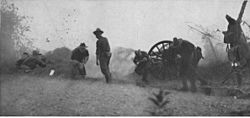
However, Western cannons in the 1800s became much more powerful, accurate, and had a very long range. For example, the American 3-inch wrought-iron cannon used in the American Civil War could shoot over 1.1 miles (1.83 km). By the 1850s, the carronade was replaced by new steel cannons.
The idea of "rifling" was first used for artillery in the 1860s. This meant casting spiral grooves inside the barrel, which made the cannonball spin and fly much more accurately. The term "cannon fodder" was first used in 1814 to describe soldiers as just "food for powder," showing a harsh view of infantry facing powerful artillery.
The better cannon technology of Western countries gave them huge advantages in wars. For example, in the First Opium War in China, British warships could bombard coastal areas safely from a distance, out of reach of Chinese cannons. The shortest war ever, the Anglo-Zanzibar War of 1896, ended quickly because of shelling from British warships.
Modern Cannons
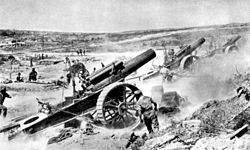
A modern cannon is a versatile weapon. It can fire directly at a target, like a tank gun, or it can fire indirectly, sending shells high into the air to land on targets far away, like a howitzer. Since World War I, the term "cannon" usually means a gun with a barrel size of about 20 mm to 125 mm. These often have automatic loading systems and can fire explosive ammunition. These are called "auto-cannons."
The smallest size for a cannon, 20 mm, has been a standard since World War II. Famous examples include the Bofors 40 mm gun and the Oerlikon 20 mm cannon, which are still used today.
Many countries use modern cannons on their lighter vehicles. For example, the 25 mm 'Bushmaster' chain gun is found on vehicles like the LAV and M2 Bradley. On the other hand, the huge guns on the USS Wisconsin and USS Missouri could fire shells a distance of 39 km!
There have been big changes in how cannons are used in modern warfare. "Superguns" were developed in the early 1900s, like the 20 cm "Paris Gun" from World War I, which had the longest range of any gun, reaching 122 km. There have even been tests with nuclear cannons in the 1950s. Today, some artillery can fire guided missiles, and special artillery can even fire shells very high into the atmosphere.
Cannons are also used for peaceful purposes, like water cannons (for crowd control or cleaning), snow cannons (to make snow), hail cannons (to try and prevent hail), and cannon netting (to catch birds or animals).
Images for kids
-
Bronze cannon with inscription dated the 3rd year of the Zhiyuan era (1332) of the Yuan dynasty (1271–1368); it was discovered at the Yunju Temple of Fangshan District, Beijing in 1935.
-
A bronze "thousand ball thunder cannon" from the Huolongjing.
-
The Dardanelles Gun, a 1464 Ottoman bombard
-
Malik E Maidan, a 16th-century cannon, was effectively used by the Deccan sultanates, and was the largest cannon operated during the Battle of Talikota.
-
Illustration by William Simpson shows action in a British artillery battery during the Crimean War with cannon firing and being loaded and men bringing in supplies.
-
A 3-inch Parrott rifle from the Battle of Chancellorsville
-
Armstrong gun deployed by Japan during the Boshin War (1868–69).
-
The 1870s de Bange 90 mm cannon on the yard of Eastern Finland military office in Mikkeli, South Savonia, Finland
-
USS Iowa firing her 16 in (41 cm) guns
-
The Tsar Cannon, the largest howitzer ever made, cast by Andrey Chokhov
-
Remains of a post-medieval cannon battery, mounted on a medieval town wall, although without carriages.
See also
 In Spanish: Cañón (artillería) para niños
In Spanish: Cañón (artillería) para niños


